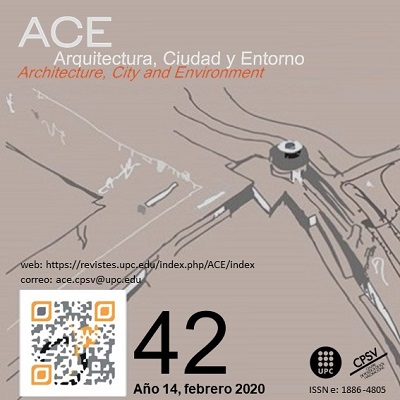La génesis de los paseos litorales: el caso de la fachada marítima urbana de Alicante
DOI:
https://doi.org/10.5821/ace.14.42.8271Palabras clave:
Frente costero, paseo litoral, waterfront, explanadaResumen
La definición, secuencial y estructurada, de las diferentes circunstancias que han dado lugar a los paseos que conforman hoy la fachada marítima de la ciudad de Alicante es el objetivo principal de este artículo. Si bien los paseos litorales son hoy los puntos de referencia de nuestras ciudades costeras, eminentemente turísticas, la bibliografía al respecto es escasa. Los resultados de este estudio contribuirán al entendimiento del fenómeno de su génesis, como fragmentos urbanos en relación con la historia y desarrollo del resto de la urbe, así como aportarán un mayor conocimiento de la problemática de su vertebración y del importante papel que juegan en el futuro inmediato de la ciudad. Para entender el proceso de conformación de los paseos litorales es necesario estudiar la evolución del frente marítimo y su entorno, así como los acontecimientos históricos, sociales, culturales y políticos que han influido en su devenir. Se trata de una investigación en la que, mediante el estudio pormenorizado de cada uno de los elementos que conforman la fachada costera, se analizan los cambios morfológicos experimentados por ésta, de acuerdo con la variable función que ha desempeñado a lo largo del tiempo. El rol predominante de la fachada marítima alicantina durante siglos fue el defensivo, sirviendo simultáneamente de marco al puerto. En el siglo XIX, con la llegada del ferrocarril, el auge de los baños de mar y el derribo de las murallas, la función de defensa fue sustituida por la lúdico-representativa que, aunque con modificaciones, permanecerá hasta nuestros días.
Publicado
Número
Sección
Licencia
COPYRIGHT
El contenido de los artículos y los comentarios en ellos expresados son responsabilidad exclusiva de sus autores, y no reflejan necesariamente la opinión del comité editor de la revista. Los trabajos publicados por ACE pueden reproducirse bajo la licencia CC-BY-NC-ND 3.0 ES más información http://creativecommons.org/licenses/by-nc-nd/3.0/es/
Lo que implica que las personas autoras sólo retienen y mantienen los derechos de Copyright dentro de las limitaciones incluidas en la licencia anterior.





































